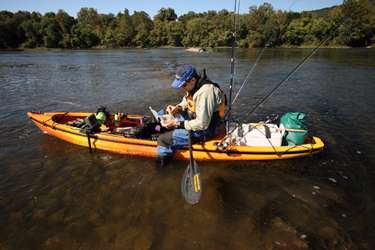
I stood staring at the kayak for a moment. “Are you taking all that today?” I asked.
“Uh, yeah, why not?” responded fellow angler Jeff Little. Dry bags, a salvaged cooler, mix-matched tackleboxes, handfuls of lures and an assortment of tools rounded out his chosen cargo.
“Do you remember that show ‘Sanford and Son’?” I inquired. The immediate pause in his get-to-the-water-scamper confirmed that he understood my comparison.
“Just shut up and get ready!” he said while flashing a grin just before we shoved off for a day on the river.
Like most people, I have clutter everywhere in my life. The drink holder in my truck is filled with change, the dash cubby holds a tangled mess of lures, the kitchen counter has piles of junk mail and every corner of the garage is overflowing. I’ve had to work very hard to overcome this tendency and continuously evaluate the gear I carry on a particular trip.
Initially, I carried one small box, a couple bags of plastics and a film canister with terminal tackle. From there, I evolved into a floating tackle store and have slowly transitioned to a more manageable middle ground. I think we’re all fearful that we will leave the hot lure at home or run out of a favorite color.
Tournament bass anglers understand the necessity for an efficient layout and easy access to eliminate wasted time sorting and searching. Even if you aren’t fishing for a payday, you should use the same approach. Reduced fumbling through the kayak improves the likelihood of having what you need, when you need it, and under changing conditions this can be instrumental to a successful day on the water.
If you’re just getting started, I would suggest visiting kayak fishing forums or pro shops and pouring over photos for ideas. Rigging should be something that evolves, not something that just happens.
Make sure an item will fit your fishing style and environment before adding it to your arsenal. Rod management, a gear/tackle bag and a kayak fishing specific PFD (personal flotation device) are the key elements of my system.
For rod management, I use flush mount and articulating holders to secure my rods depending on the kayak and conditions. Rods are best stored horizontally to avoid entanglement near shoreline cover. To accomplish this, I use a foam block to lay the rods between my legs, an adjustable rod holder or store them lying flat under the rear tankwell bungee.
When selecting a gear bag, I look for durability with room for three large tackleboxes, two smaller ones for terminal tackle, a worm bag for soft plastics and a couple of miscellaneous pockets. Commercially available alternatives to the popular milk crate offer more flexibility, convenience, reduce noise and organize your gear much more effectively.
My PFD has ample pockets, and I use it to carry hooks, small weights, rattles, adhesive weights, etc. Additionally, it is the attachment point for line clippers, lanyard cutter, VHF radio, safety whistle and utility knife. Basically, it serves as a safety device while also keeping my other essentials readily available. Beyond safety, my PFD is an integral part of the way I fish, and I wear it all the time.
Take some time when choosing mounting locations, gear storage options and setting up your own intuitive system to make your time on the water more rewarding.
Next week we move away from the basics and explore trying new approaches, techniques and presentations.
Editor’s Note: Chad Hoover is originally from Louisiana and is currently on active duty in the U.S. Navy, stationed in Norfolk, Va. He is the owner of www.KayakBassFishing.com and author of Kayak Bass Fishing ($24.95 on his site). He also serves as the kayak Pro Staff Director for Wilderness Systems kayaks, Torqeedo motors and Secret Weapon Lures.




